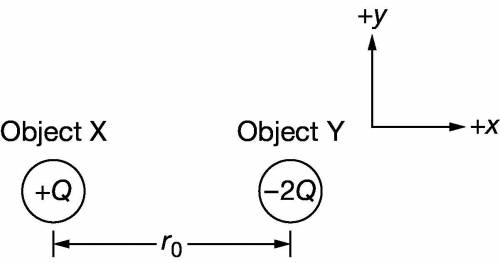
Physics, 30.11.2020 02:20 alize123213
Object X and object Y, of charge +Q and −2Q, respectively, are separated by a distance r0, as shown in the figure.
(a) Determine an equation for the magnitude and direction of the electric force that is exerted on object Y from object X in terms of Q, r0, and physical constants, as appropriate.
(b) The charge of object X is changed so that it has a charge of −4Q, and the separation distance between the two objects is changed to 2r0. In a clear, coherent paragraph-length response that may also contain figures and/or equations, predict how the electric force exerted on object Y from object X changes from part (a), and predict how the net charge of the two object system changes from part (a).


Answers: 3
Another question on Physics

Physics, 22.06.2019 00:30
Consider an ordinary, helium-filled party balloon with a volume of 2.2 ft3. the lifting force on the balloon due to the outside air is the net resultant of the pressure distribution exerted on the exterior surface of the balloon. using this fact, we can derive archimedes’ principle, namely that the upward force on the balloon is equal to the weight of the air displaced by the balloon. assuming that the balloon is at sea level, where the air density is 0.002377 slug/ft3, calculate the maximum weight that can be lifted by the balloon. note: the molecular weight of air is 28.8 and that of helium is 4.
Answers: 2

Physics, 22.06.2019 03:30
As part of an industrial process, air as an ideal gas at 10 bar, 400k expands at steady state through a valve to a pressure of 4 bar. the mass flow rate of air is 0.5 kg/s. the air then passes through a heat exchanger where it is cooled to a temperature of 295k with negligible change in pressure. the valve can be modeled as a throttling process, and kinetic and potential energy effects can be neglected. (a) for a control volume enclosing the valve and heat exchanger and enough of the local surroundings that the heat transfer occurs at the ambient temperature of 295 k, determine the rate of entropy production, in kw/k. (b) if the expansion valve were replaced by an adiabatic turbine operating isentropically, what would be the entropy production? compare the results of parts (a) and (b) and discuss.
Answers: 3

Physics, 22.06.2019 09:30
Acar traveling at 22 m/s starts to decelerate steadily. it comes to a complete stop in 15 seconds. what is it’s acceleration?
Answers: 1

Physics, 22.06.2019 11:20
If a rock is thrown upward on the planet mars with a velocity of 12 m/s, its height (in meters) after t seconds is given by h = 12t − 1.86t2. (a) find the velocity of the rock after two seconds. m/s (b) find the velocity of the rock when t = a. 12−3.72a m/s (c) when will the rock hit the surface? (round your answer to one decimal place.) t = s (d) with what velocity will the rock hit the surface? m/s
Answers: 1
You know the right answer?
Object X and object Y, of charge +Q and −2Q, respectively, are separated by a distance r0, as shown...
Questions

Mathematics, 17.10.2019 20:10


Mathematics, 17.10.2019 20:10

Physics, 17.10.2019 20:10

Mathematics, 17.10.2019 20:10

Mathematics, 17.10.2019 20:10



Mathematics, 17.10.2019 20:20







Mathematics, 17.10.2019 20:20










